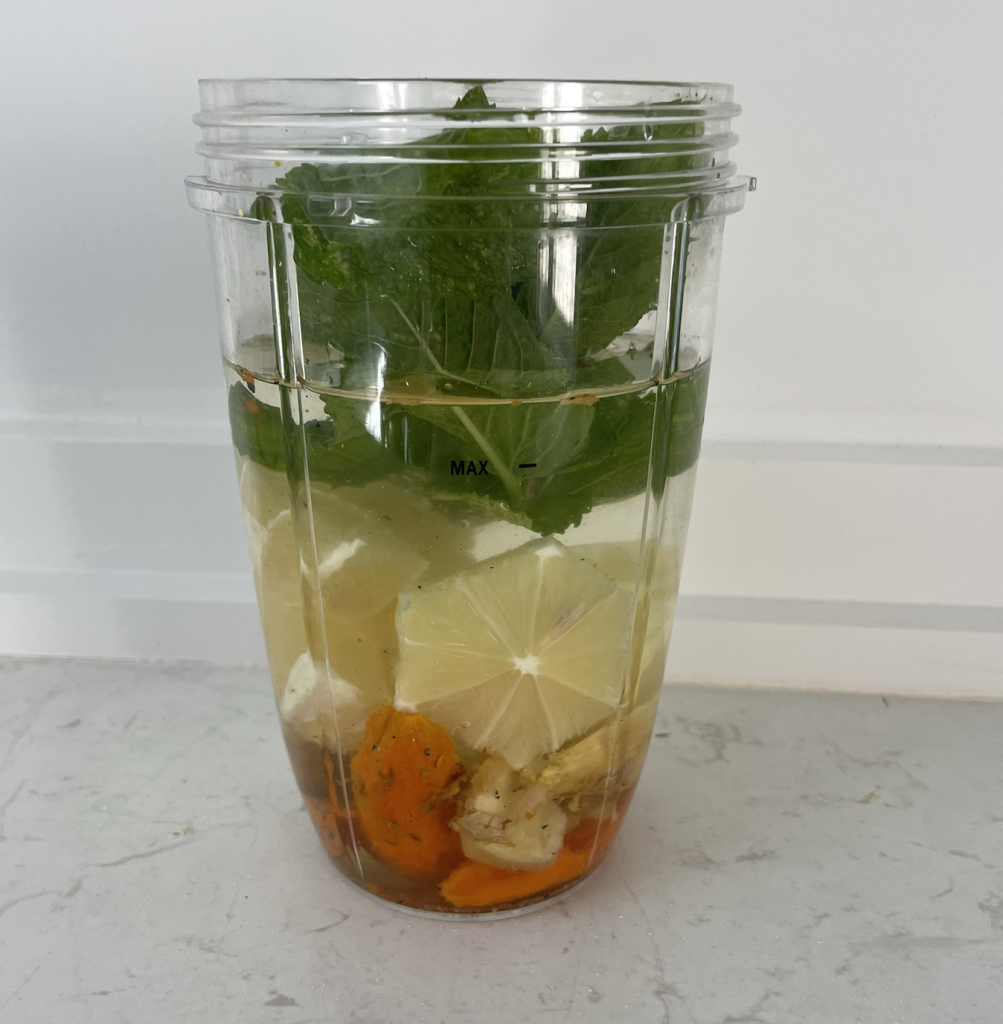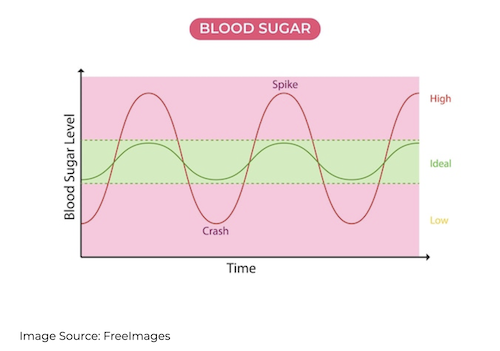
If I’m feeling headachey and tired or my knees start hurting, I know my body is inflamed and needs anti-inflammatory assistance. That’s where the health benefits of a ginger, turmeric and lemon drink come into play. Combining ginger, turmeric, mint and lemon has an array of amazing health benefits from reducing inflammation, to enhancing digestion and boosting immunity.
If you’ve been on the fence about trying this drink, read about the health benefits below.
What Are The Health Benefits?
Ginger
- Digestive helper: Ginger helps to accelerate the speed at which food moves through your digestive tract (Aregawi et al., 2023).
- Anti-Inflammatory and Antioxidant: Ginger has anti-inflammatory and antioxidant benefits which are beneficial to cell health (Aregawi et al., 2023).
- Immunity: Ginger has antimicrobial and antifungal properties that help fight off bad bacteria, that could cause harm the body (Park et al., 2008).
- Nausea Aid: Helps reduce symptoms of nausea (Aregawi et al., 2023).
Turmeric
- Anti-Inflammatory: Turmeric is high in curcumin which is an active compound that provides powerful anti-inflammatory benefits (Dehzad et al., 2023).
- Antioxidant: It reduces oxidative stress which is beneficial to your cells’ health (Dehzad et al., 2023).
- Knee Health: Supplementing with turmeric can help alleviate knee/ joint pain which helps with mobility (Paultre et al., 2021).
- Rheumatoid arthritis: Studies show curcumin is beneficial as a rheumatoid arthritis treatment (Kou et al., 2023).
Lemon
- Digestive Booster: Lemons help to stimulate digestion which helps with the overall health of your gut (Freitas et al., 2022).
- Energy Aid: Helps to alleviate fatigue (Shimizu et al., 2019).
- Vitamin C: Lemons are rich in vitamin C which helps fight off colds and boost the immune system (Miles & Calder, 2021).
- Detoxification: The Vitamin C in lemons can be used to flush the body of toxins (Rahm, 2024).
Mint
- Cancer prevention: Studies show the phytochemicals in mint can help fight off cancer production in the body for cancers like breast, cervix, lung and many other types (Tafrihi et al., 2021).
- Antioxidant powerhouse: Full of antioxidant properties, which boosts cell health by reducing free radicals (Tafrihi et al., 2021).
Black Pepper
- Enhances Tumeric: Black pepper helps improve the bioavailability (the absorption) of the curcumin in turmeric so is a necessary addition to this drink (Pour et al., 2023).
- Digestion: Black pepper stimulates digestive enzymes in the pancreas which reduces the total food transit time through the gut (Srinivasan, 2007).
What You Should Keep The Fibre In and Not Strain It
You may see other recipes where they recommend you strain your ginger, turmeric, mint and lemon drink but this reduces so many benefits. Keeping your fibre in can help in many ways:
Digestion
Keeping the fibre assists your digestive system but adds bulk to your stool which helps regulate bowel movements, supporting an overall healthy gut (Barber et al., 2020).
Regulates Blood Pressure
Fibre helps to lower blood pressure and cholesterol levels in the blood, meaning your energy levels are more consistent throughout the day (Anderson et al., 2009).
Lower Body Weight
Having fibre in your diet helps to keep you full for longer which is a beneficial aid in weight maintenance and studies have shown, that increased fibre intake is associated with a lower body weight (Clark & Slavin, 2013).
Boosts gut health
Fibre is a prebiotic, which helps to feed the beneficial bacteria in your gut and adds to an overall healthy gut microbiome (Alahmari, 2024).
Turmeric Ginger Lemon Mint Shot Recipe
Get your ingredients ready

Weigh and scrape off the peel from the turmeric and ginger


Pro Tip: Wear gloves to avoid staining your hands!

Cut of lemon rinds

wash mint

Add turmeric, ginger, lemon, pepper, mint and water into a blender


Pour and serve

Ingredients
**Makes 7 shots/days worth**
- 2 lemons peeled
- 1 large knob fresh ginger peeled 45-50grams
- Tumeric peeled 45-50grams
- A pinch of black pepper
- 250mls water
- 1 teaspoon honey (optional)
- small bunch of mint leaves (optional)
Instructions
- Weigh out turmeric and ginger so you have roughly equal amounts.
- Using a spoon, scrape off the skin from the turmeric and ginger. Pro Tip: Wear gloves to avoid the turmeric staining your hands.
- Cut the lemon rind of your lemon and cut into quarters.
- Wash mint.
- Combine turmeric, ginger, lemon, pepper, mint and water into a blender and blend. Add more water to adjust to your liking.
- Pour the drink into a jar for storage and a glass to have immediately as a shot.
When is the Best Time to Drink it?
I find that when I have my ginger, turmeric, mint, and lemon drink on an empty stomach first thing in the morning, my body is better able to absorb the ingredients, and it also kickstarts my digestion for the day.
However, one study showed that lemon can reduce insulin spikes by 30% before eating bread, so sometimes I like to take this before lunch or dinner especially if I’m having a carb-rich meal (Freitas et al., 2020). You want your insulin to rise and fall in a steady nature as the higher the spike, the more quickly you get hungry again (Flint et al., 2007).

The Bottom Line
A turmeric, ginger, lemon, pepper, mint, and water drink is a fantastic way to boost your health in many ways. Whether you use it to curb your appetite, boost your digestion, reduce inflammation, or for any other benefit, if you drink it regularly, your body will thank you.
For more wellness-related recipes or blogs, check out our wellness page.
Let me know if you’ve tried this drink or a variation in the comments.
until next time,
Greta @ How To Turn Your Life Around
Related Reads:
- How to heal your gut health for beginners
- Can cycle-syncing help you reach your body goals?
- How to Build a Strong Morning Routine Backed by Research
References:
Alahmari, L. A. (2024). Dietary fiber influence on overall health, with an emphasis on CVD, diabetes, obesity, colon cancer, and inflammation. Frontiers in Nutrition, 11. https://doi.org/10.3389/fnut.2024.1510564
Anderson, J. W., Baird, P., Davis, R. H., Jr., Ferreri, S., Knudtson, M., Koraym, A., Waters, V., & Williams, C. L. (2009). Health benefits of dietary fiber. Nutrition Reviews, 67(4), 188–205. https://doi.org/10.1111/j.1753-4887.2009.00189.x
Aregawi, L. G., Shokrolahi, M., Gebremeskel, T. G., & Zoltan, C. (2023). The effect of ginger supplementation on the improvement of dyspeptic symptoms in patients with functional dyspepsia. Cureus. https://doi.org/10.7759/cureus.46061
Barber, T. M., Kabisch, S., Pfeiffer, A. F. H., & Weickert, M. O. (2020). The health benefits of dietary fibre. Nutrients, 12(10), 3209. https://doi.org/10.3390/nu12103209
Clark, M. J., & Slavin, J. L. (2013). The Effect of fiber on satiety and food intake: a systematic review. Journal of the American College of Nutrition, 32(3), 200–211. https://doi.org/10.1080/07315724.2013.791194
Dehzad, M. J., Ghalandari, H., Nouri, M., & Askarpour, M. (2023). Antioxidant and anti-inflammatory effects of curcumin/turmeric supplementation in adults: A GRADE-assessed systematic review and dose–response meta-analysis of randomized controlled trials. Cytokine, 164, 156144. https://doi.org/10.1016/j.cyto.2023.156144
Flint, A., Gregersen, N. T., Gluud, L. L., Møller, B. K., Raben, A., Tetens, I., Verdich, C., & Astrup, A. (2007). Associations between postprandial insulin and blood glucose responses, appetite sensations and energy intake in normal weight and overweight individuals: a meta-analysis of test meal studies. British Journal of Nutrition, 98(1), 17–25. https://doi.org/10.1017/s000711450768297x
Freitas, D., Boué, F., Benallaoua, M., Airinei, G., Benamouzig, R., & Feunteun, S. L. (2020). Lemon juice, but not tea, reduces the glycemic response to bread in healthy volunteers: a randomized crossover trial. European Journal of Nutrition, 60(1), 113–122. https://doi.org/10.1007/s00394-020-02228-x
Freitas, D., Boué, F., Benallaoua, M., Airinei, G., Benamouzig, R., Lutton, E., Jourdain, L., Dubuisson, R., Maître, X., Darrasse, L., & Feunteun, S. L. (2022). Glycemic response, satiety, gastric secretions and emptying after bread consumption with water, tea or lemon juice: a randomized crossover intervention using MRI. European Journal of Nutrition, 61(3), 1621–1636. https://doi.org/10.1007/s00394-021-02762-2
Kou, H., Huang, L., Jin, M., He, Q., Zhang, R., & Ma, J. (2023b). Effect of curcumin on rheumatoid arthritis: a systematic review and meta-analysis. Frontiers in Immunology, 14. https://doi.org/10.3389/fimmu.2023.1121655
Miles, E. A., & Calder, P. C. (2021). Effects of citrus fruit juices and their bioactive components on inflammation and immunity: a narrative review. Frontiers in Immunology, 12. https://doi.org/10.3389/fimmu.2021.712608
Park, M., Bae, J., & Lee, D. (2008). Antibacterial activity of [10]‐gingerol and [12]‐gingerol isolated from ginger rhizome against periodontal bacteria. Phytotherapy Research, 22(11), 1446–1449. https://doi.org/10.1002/ptr.2473
Paultre, K., Cade, W., Hernandez, D., Reynolds, J., Greif, D., & Best, T. M. (2021). Therapeutic effects of turmeric or curcumin extract on pain and function for individuals with knee osteoarthritis: a systematic review. BMJ Open Sport & Exercise Medicine, 7(1), e000935. https://doi.org/10.1136/bmjsem-2020-000935
Pour, S. K., Blanton, C., Ghimire, B., & Aghazadeh‐Habashi, A. (2023b). Development of a rapid, sensitive, and selective LC–MS/MS method for quantifying curcumin levels in healthy human urine: Effect of pepper on curcumin bioavailability. Food Science & Nutrition, 11(12), 7732–7741. https://doi.org/10.1002/fsn3.3691
Rahm, C. (2024). Detoxing & remediating land, air, and water & implications on human and animal health. PriMera Scientific Surgical Research and Practice, 4(3), 77–81. https://primerascientific.com/pdf/pssrp/PSSRP-04-133.pdf
Shimizu, C., Wakita, Y., Inoue, T., Hiramitsu, M., Okada, M., Mitani, Y., Segawa, S., Tsuchiya, Y., & Nabeshima, T. (2019). Effects of lifelong intake of lemon polyphenols on aging and intestinal microbiome in the senescence-accelerated mouse prone 1 (SAMP1). Scientific Reports, 9(1). https://doi.org/10.1038/s41598-019-40253-x
Srinivasan, K. (2007). Black Pepper and its Pungent Principle-Piperine: A Review of Diverse Physiological Effects. Critical Reviews in Food Science and Nutrition, 47(8), 735–748. https://doi.org/10.1080/10408390601062054
Tafrihi, M., Imran, M., Tufail, T., Gondal, T. A., Caruso, G., Sharma, S., Sharma, R., Atanassova, M., Atanassov, L., Fokou, P. V. T., & Pezzani, R. (2021). The wonderful activities of the genus Mentha: not only antioxidant properties. Molecules, 26(4), 1118. https://doi.org/10.3390/molecules26041118
Disclaimer:
The information provided on this blog is for general informational purposes only and is not intended as medical, professional, or legal advice. While we strive to provide accurate and up-to-date content, there may be occasional errors, including incorrect links, outdated information, or unintentional omissions. These mistakes can occur due to human error, and we encourage readers to double-check external sources when necessary.
Any health or wellness tips shared on this site should not be considered a substitute for professional medical advice, diagnosis, or treatment. Always seek the advice of your physician or other qualified health provider with any questions you may have regarding a medical condition or before making any changes to your health routine.
We are not responsible for any actions taken based on the information presented on this blog. By reading this blog, you agree to the terms of this disclaimer and acknowledge that the content is intended to be a resource, not a solution for individual medical needs.
Thank you for your understanding!
good to know about benefits ,keep it up
Thanks Nilay! 🫶